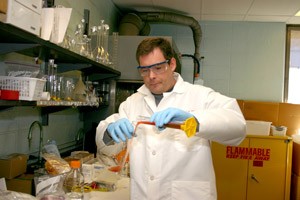
UC Chemistry Research Looks to Turn Food Waste into Fuel
Three
undergraduate researchers recently spent time at the Ho Chi Minh City (HCMC) University of Science, in Vietnam, working on ways to turn food waste into biodiesel fuel. Cody Nubel, Megan McCallister and Zachary Herrmann joined Professor Allan Pinhas and graduate researchers, Amos Doepke and Chau Phung, on a joint research project with Lawrence Pratt of Fisk University.
The project, Biodiesel Fuel from Food Waste, focuses on the potential to produce biodiesel from oil extracted from garbage. With the depletion of oil reserves, research into alternative fuels has exploded, especially in the area of renewable resources such as garbage and food waste. One particular resource, brown grease from food waste, has yet to realize its full potential, but thanks to the efforts of
chemistry researchers, the project is finding ways to optimize this resource.
One of the goals of the project was to determine the amount of usable oil that can be obtained from food waste. To do this, the researchers collected food wasteby hand from an HCMC University of Science student canteen as well as a private residence. Samples of the food waste were then either sun-dried or dried in an ovena process Nubel describes as extremely dirty and smellyand then ground up and loaded into a homemade extraction thimble bag so that oils contained in the food could be extracted through a Soxhlet extraction.

Food waste was sun-dried for extraction purposes.
It was during the extraction process that Nubel made an important discovery. During this step I determined a much more efficient way of pulling remnants of oil from the bag by using the suction formed from the extractor.
McCallister, who also helped with the food waste collection, sample preparation and oil extraction, adds that after the extraction, we converted the oil into biofuel through an acid-based reaction.
Part of the conversion process requires that the extracted oil be degummed to further purify it. During the degumming process we realized that layer separation is best completed through centrifuge rather than other conventional methods because its both higher yielding and much quickerby about 24 hours, says Nubel.

Researchers used the Soxhlet apparatus to extract oil from the waste samples.
From there, the oil was converted to biodiesel fuel by using a solvent, which required the researchers to determine the correct amount of solvent to add per time and heat in order to yield the highest amount of biodiesel fuel.
Despite the complexity of the processand the sometimes unseemly conditionsthe results were worth the effort. This job may have easily qualified for Mike Rowes show, Dirty Jobs, but the experiment was a success and the results are awaiting publication, says Nubel.
Herrmann also worked on the project, though in a slightly different area. He worked on taking vegetation found in Vietnam and extracting compounds from them. In a process similar to the Soxhlet extraction, Herrmann used column chromatography, which meant he also had to grind up the plants so that compounds could be extracted. My job was to run these columns and attempt to purify one compound from thousands. We did manage to separate one compound from the plant we worked on and it was the first time that the compound had been extracted from that plant, he says.
Not only was the research project a success, but so were the researchers themselves. Pinhas says, What I was told in Vietnam is that the group of students from UC was the best group of students that ever participated in this program with chemists in Vietnam.
Related Stories
President Pinto shares search update for executive vice...
March 25, 2025
President Neville Pinto shares search update for executive vice president for academic affairs and provost
Ohio takes steps to stop spread of invasive pear trees
March 21, 2025
WLWT talks to UC biology Professor Theresa Culley about Ohio's ban on the sale or planting of nonnative and invasive pear trees. The trees are showing up in many parks and wild areas where they are crowding out native species.
UC’s renovated Old Chem will feature bird-safe glass
March 21, 2025
Renovations to a building at the University of Cincinnati feature windows designed to prevent the needless deaths of migratory birds.
